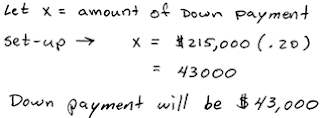Tip: Read the problem several times before starting and try to understand the question.
Number Problem: The sum of two integers is 18. The larger number is 2 less than 3 times the smaller. Find the integers.
Number Problem: The difference between two integers is 2. The larger number is 6 less than twice the smaller. Find the integers.
Many times we can figure out these types of word problems by guessing and checking. This is the case because the numbers are chosen to be simple, so the algebraic steps will not be too tedious. You are learning to set up algebraic equations on these easier problems, so that you can use these ideas to solve more difficult ones later.
Tip: For full credit your instructor will insist that you use algebra to solve the word problems. Don't fight it, just identify the variables and use them to set up an algebraic equation.
Number Problem: One number is 3 more than another number. When two times the larger number is subtracted from 3 times the smaller number, the result is 6. Find the numbers.
It is important to notice that both even and odd integers are separated by two units.
Consecutive Odd Integers: The sum of two consecutive odd integers is 36. Find the integers.
Consecutive Even Integers: The sum of two consecutive even integers is 46. Find the integers.Caution: A common mistake is to set up consecutive odds with an x and x + 3. This will most likely lead to a decimal answer which certainly is not an integer and is incorrect. Make sure that you read the problems carefully; notice that consecutive integers are separated by 1 unit.
Consecutive Integers: The sum of three consecutive integers is 24. Find the integers.
You will need to ask your instructor if you will be able to use a calculator. In either case, you should be able to work with decimals by hand. When money is involved be sure to round off to two decimal places.
Tax Problem: If a pair of Nike shoes cost $48.95 plus a 7 1/4% sales tax, what will the total be at the register?
Tax Problem: At 8 3/4% the amount of sales tax on an item came to $12.04. What was the cost of the item?Tax Problem: A local non-profit was mistakenly charged $2,005.84 which included a 7 1/4% sales tax charge. If tax was not to be included how much refund is the company due?
Taxicab Problem: A taxicab charges $5.00 for the ride plus $1.25 per mile. How much will a 53 mile trip cost?
Rental Problem: If a rental car cost Jose $35.00 for the day plus $0.33 per mile and his total cost was $78.00, then how many miles did he drive?Any Algebra textbook will have steps or guidelines for solving word problems. These steps are all generally the same and are outlined below. However, nothing works better to improve your word problem skills more than practice.
Basic Guidelines for Solving Word Problems:
- Read the problem several times and organize the given information.
- Identify the variables by assigning a letter to the unknown quantity.
- Set up an algebraic equation.
- Solve the equation.
- Finally, answer the question and make sure it makes sense.
Geometry Problem: A rectangle has a perimeter measuring 64 feet. The length is 4 feet more than 3 times the width. Find the dimensions of the rectangle.
Geometry Problem: The perimeter of an equilateral triangle measures 63 cm. Find the length of each side.
Geometry Problem: Two sides of a triangle are 5 and 7 inches longer than the third side. If the perimeter measures 21 inches, find the length of each side.
Some perimeter formulas you are expected to know: ( π = 3.14)
Perimeter of a Circle: C = 2πr
Perimeter of a Triangle: P = a + b + c
Perimeter of a Square: P = 4s
Video Example: Find the Area of a Rectangle Given the Perimeter
Percent Problem: A $215,000 house requires a 20% down payment. How much will the down payment be for this home?

Percent Increase: A discount store paid $35.50 for a dress they are selling for $49.99. What is the store markup on this item?
Whenever setting up a percent problem always use the decimal or fractional equivalent of the percent. Generally, we wish to use real numbers in algebra. For example, instead of using 50 for 50% we will need to use 0.50 or 1/2. Also, if the question asks for a percentage then do not forget to convert your answer to percent.
Distance Problem: The 375 mile drive to Las Vegas took 5 hours. What was the average speed?Distance Problem: Two trains leave the station at the same time traveling in opposite directions. One travels at 70 miles per hour and the other travels at 60 miles per hour. How long does it take for them to become 390 miles apart?
Distance Problem: Joe and Bill are traveling across the country. Joe leaves one hour earlier than Bill at a rate of 60 miles per hour. If Bill leaves at a rate of 70 miles per hour, how long will it take him to catch up to Bill?
Video Examples on YouTube:

J. Redden on G+






































































































comment 0 التعليقات:
more_vertsentiment_satisfied Emoticon